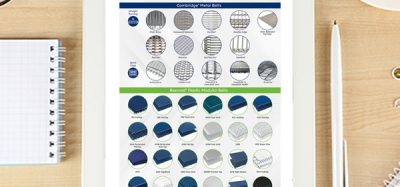EHEDG: Conveyor Belts – Hygiene in metal conveyor belting
- Like
- Digg
- Del
- Tumblr
- VKontakte
- Buffer
- Love This
- Odnoklassniki
- Meneame
- Blogger
- Amazon
- Yahoo Mail
- Gmail
- AOL
- Newsvine
- HackerNews
- Evernote
- MySpace
- Mail.ru
- Viadeo
- Line
- Comments
- Yummly
- SMS
- Viber
- Telegram
- Subscribe
- Skype
- Facebook Messenger
- Kakao
- LiveJournal
- Yammer
- Edgar
- Fintel
- Mix
- Instapaper
- Copy Link
Posted: 4 November 2013 | Roger Scheffler, EHEDG Member | No comments yet
Undoubtedly, stainless steel is the best and mostly used material in the food industry. The correct application of specific types mainly depends on the mechanical aspects of an application, the corrosive properties of products, disinfecting and cleaning agents. Its properties overall qualify the material stainless steel to be the preferred choice in food processing environment.


Roger Scheffler, EHEDG Member


Roger Scheffler, EHEDG Member
Undoubtedly, stainless steel is the best and mostly used material in the food industry. The correct application of specific types mainly depends on the mechanical aspects of an application, the corrosive properties of products, disinfecting and cleaning agents. Its properties overall qualify the material stainless steel to be the preferred choice in food processing environment.
But, when it comes to stainless steel being used in the form of a conveyor belt, then there are more aspects to consider than just the material. Features like drive concept, tension mode, gliding concept, handling properties during sanitation, etc. may force the end user, i.e. the food processor, or the technical belt engineer from a machine manufacturer (OEM) to look into a broader scope of the right belt selection.
The three main stainless steel belt types in food processing are:
- Wire belting
- Metal belting
- Flat steel belting.
Wire belting
Woven wire belts can be used in straight and curve applications, horizontal or inclined. The woven wire construction offers an open grid area. This open grid area gives the cleaner the chance to easily flush through the belt in order to clean the belt as well as other conveyor components like wear strips, drive units, gliding profiles in the return way and other parts of the conveyor. This ‘flush through’ cleaning feature is a huge advantage when talking about the sanitation of wire belts.
Care should be taken when cleaning the belt in order to prevent damage of the belt. The wire belt can be easily damaged by very robust handling through cleaning or during production. The wires can be bent which leads to the risk of the belt touching the conveyor frame which can lead to possible breakages. This is definitively a hygiene risk that should be considered when wire belts get chosen for food processing machines.
Another hygiene risk occurs if the wires are joined by little tubes. It is impossible to clean the tube inside and therefore it is strongly recommended to replace that section of the belt or even better the entire belt instead of using a repair kit.
Hypochlorite cleaning agents should be avoided as well as peroxide disinfectants to reduce the risk of surface pitting.
Metal belting
In relation to sanitation, hygiene and cleanability, metal link belting doesn’t differ too much from wire belting. The ladder cross rod structure offers an open area for easy cleaning of the belt as well as the inside components of a conveyor. Metal belts can have thicker metal wires that may make the surface of the belt less open and more difficult to clean, especially if product debris and moisture sticks between the grids. Metal belting can be used for straight and curve applications and often being used as spiral belts. One major hygiene risk is the grease that can occur from the belt running on wear strips or touching the drum of a spiral. Spiral steel belts (sometimes) need to be lubricated to lower the friction between the belt and friction components (like wear strips) which can create a blackening effect and this can cause the risk of product cross contamination.
Flat steel belting
Until about 15 years ago, flat steel belting had been very popular in food processing, especially in meat deboning applications where these belts had been widely used. But towards the mid / end of 1990s, steel belts had been overtaken and (with a few exceptions) replaced by the plastic modular belt technology. At first glance it might seem strange: modular plastic belts with all the hinges and niches at the underside overtaking flat steel conveyor belts that seem to be the best choice for food processing by having a flat surface, allowing easy cleaning.
The issue with the flat steel belt was (and still is) that additional components and features are required to drive and track the belt properly. Flat steel belts are not positive driven (like plastic modular belts) but friction driven. It requires belt tension to drive the belt. That means the entire conveyor is a more complex system with tension devices, tracking devices and more stabile components to take this internal force. All these components make the conveyor more complex and debilitate the advantage of having a flat surface easy to clean.
It’s not only the tension in the system that prevents easy access to all parts of the steel belt conveyor. Flat steel belts also are heavier than plastic belt technologies (e.g. plastic modular or traditional flat belts) and therefore prevent easy lifting by the cleaning operator when trying to gain better cleaning access to the inside of the frame.
Conclusion
Like any other conveyor belt technology, stainless steel belts have pros and cons. Therefore it is important to use these belts in their most suiting and appropriate applications. Every conveyor belt, no matter what belt material and type, is hygienic. Using them in applications where they are not really suitable makes them unhygienic.







